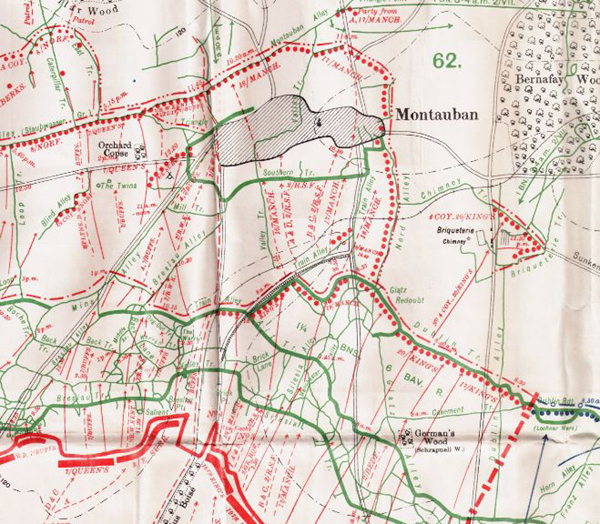Newsletters
- Details
- Category: Newsletters
Chairman’s Notes
Good Evening and welcome to the February meeting. As I cannot make the meeting, please support Phil Hamer this evening. I am sure you will enjoy Peter Hart’s talk on Jutland. I am sorry I will miss it. It has been agreed that Phil will not provide any graphics for tonight’s meeting. Those who saw his cartographical representation of the Gallipoli Peninsula will know exactly to what I am referring.
Peter has been a regular speaker on the Great War and I am sure you will be fully entertained this evening. Jutland was the only major battle between the two main fleets in the war. It was very much a battle of what if’s? However, counterfactuals are basically useless. Those who try to envisage an alternative scenario if only something had or had not happened are deluding themselves that an alternative scenario would have occurred. Any of the component facts could have been altered, so any interpretation merely reflects the personal whims of the proposer.
Enjoy the meeting.
Terry Jackson, Chairman
Last Month’s Talk
The Christmas Truce 1914 has long been the subject of reports and articles. The common theme was associated with the apparent ‘international’ friendly football match between the British and Germans. However, Taff Gillingham delved deep into the legend to ascertain the true facts of the case.
The match has been notated on several media programmes and sources throughout the years. Various bodies have reported as fact the international match on 25th December. In all there are nearly 30 versions of a match, so much so that UEFA has been involved in the commemoration.
Given his track record, the enthusiasm of Michel Platini to celebrate the truce match can be taken with a pinch of salt and possibly a pass back. (Football’s equivalent of a back hander).
Films such as the appalling ‘Joyeux Noel’ had exaggerated this fallacy. Chris Baker, former Chairman of the WFA showed by research, that there was no such evidence for any football international.
As Taff pointed out, although in some areas hostilities may have ceased, there is no evidence for an Us v Them match. Some Tommies may have kicked a tin can about, but there was no organised competitive game.
In the areas occupied by North Eastern units, there was no feeling of collaboration with an enemy that had only two weeks previously shelled residential areas of Hartlepool, Whitby and Scarborough. Even photographs purporting to show the game had only British participants and a famous still was in fact taken in Salonika.
Thus the real truce has been pushed aside and although some soldiers do mention a game, these are usually by men who were not near the front and often just saying what the interviewer wanted to hear. (Tonight’s speaker Peter Hart, as Oral Historian of the IWM has said this is a factor that an interviewer has to bear in mind).
Taff evoked many contemporary accounts of the truce. The most reliable relate to some fraternisation and possible covert attempts to have a peep at the others’ trenches. Most credible accounts present an informal kick about by the British, sometimes observed by the Germans. Kurt Zehmisch IR134 recalled observing an informal football match by the enemy only.
In his involvement with the Khaki Chums, Taff quoted numerous approaches to him from various bodies seeking information on the famous match. He was able to prove to them this had not occurred. Whether this persuaded them not to continue with a spurious report is another matter.
Unfortunately, the myth will continue, but it is up to the WFA to ensure that glib commentators do not steal the true facts of this nor any other Great War myth.
I was right in my preamble to last month’s UTL. As the Sun says.” Never let the truth get in the way of a good story”. Taff’s research has fully dispelled any such match. Ed
100 Years Ago
On 3rd February 1917, President Woodrow Wilson spoke for two hours before a historic session of Congress to announce that the United States was breaking diplomatic relations with Germany.
Due to the reintroduction of the German Navy’s policy of unlimited submarine warfare, announced two days earlier by Chancellor Theobald von Bethmann Hollwegg, Wilson stated that his government had no choice but to cut all diplomatic ties with Germany in order to uphold the honour and dignity of the United States. Though he maintained that America did not desire any hostile conflict with the German government, Wilson nevertheless cautioned that war would follow if Germany followed through on its threat to sink American ships without warning.
Later that day, Count von Bernstorff, the German ambassador to the U.S., received a note written by Secretary of State Robert Lansing stating that the President had directed him to announce to his Excellency that all diplomatic relations between the United States and the German empire were severed, and that the American Ambassador at Berlin would be immediately withdrawn. In accordance with such an announcement, Bernstorff was guaranteed safe passage out of the country, but was ordered to leave Washington immediately. Also in the wake of Wilson’s speech, all German cruisers docked in the United States were seized and the government formally demanded that all American prisoners being held in Germany be released at once.
On the same day, a German U-boat sunk the American cargo ship Housatonic off the Scilly Islands. A British ship rescued the ship’s crew, but its entire cargo of grain was lost.
In Berlin that night, before learning of the President’s speech, German Foreign Secretary Arthur Zimmermann told U.S. Ambassador James J. Gerard that everything would be all right. America would do nothing, for President Wilson was for peace and nothing else. Everything would go on as before. He was proved wrong the following morning, as news arrived of the break in relations between America and Germany, a decisive step towards U.S. entry into the First World War.
- Details
- Category: Newsletters
The newsletters for the current year are here.
- Details
- Category: Newsletters
Chairman’s notes
Good Evening and welcome to the first meeting of 2017. I trust that you have all had a good Christmas and New Year. We spent the former in Alicante and were fortunate to have a hotel overlooking the marina and sea. We also enjoyed excellent weather.
100 years ago the Allies were looking to force the Germans onto the back foot. The Somme had not provided the hoped for breakthrough for the Allies nor had the German offensive at Verdun been successful. The turn of the year was to see a change in leadership for both France and Germany. The Americans were beginning to arrive, but the plight of the Russians was increasing. Britain had a new Prime Minister who was to actively interfere in the workings of the military effort, often with severe results.
I am pleased to welcome back Taff Gillingham back to the Branch. Many of you will remember his talk on the personal equipment of the British soldier. I have a lasting picture of Taff proving how effective the pack was by completely inverting his colleague to show that even in this position the soldier would still remain securely bound to his webbing.
Taff, of course, is also an expert on the Western Front. During the Somme period last year, he appeared on several programmes. I was also pleased to meet him at the Suffolk Memorial, Le Cateau on 26th August 2014 at the 100th anniversary of that battle.
Taff will be analysing the ‘Christmas Truce’ of 1914, with particular emphasis on the ’International Football Match’. In a region where football still forms an important part of life with the two Manchester giants and numerous teams from professional to amateur level still active, the truce will be an interesting topic. Like much of the popular history of the war, a lot of added and unfounded details have been used to embellish the scene in the ‘Sun’ motto of ‘Never let the truth get in the way of a good story’. I am sure Taff will cut through the fog to reveal the true events.
Terry Jackson. Chairman
Last month’s talk
I was especially pleased to welcome John Hartley to the Branch. John had produced his work on Stockport Servicemen lost in the Great War, ‘More Than a Name’. The detailed records of these men have been essential in my research on Stockport Corporation employees who gave their lives.
John’s talk concentrated on the 17th Battalion Manchester Regiment, one of the Pals’ Battalions. Manchester had become the dominant world city during the cotton era. However, many of the early volunteers from the industrial cities had been workmen. An organised commercial and financial sector was essential to run the major industries in world trade.
By early September recruiting was ebbing and Kitchener targeted the middle classes. The North West was the home ground of Lord Derby, who was to implement an interim scheme of attestation before Conscription eventually came. Although the TAs did provide some of these men, many were unable to accommodate huge influxes, so Kitchener had decided to create a third strand behind them and the regulars. These became known as the Service Battalions.
As the war intensified the ‘pen pushers’ were in danger of being cast as avoiding the fray. However, their patriotism was as intense as their manual brothers and they too began to seek to serve the nation in the field.
Eventually after training the Battalion went overseas and their first casualty in the field was 2nd Lieutenant Robert Loudon Johnston. He was killed on 13 February 1915 after being struck by the casing ejected from a nearby artillery piece.
On 1 July 1916, 16,17&18th Manchester Regiment with 2nd Royal Scots Fusiliers formed 90th Brigade of 30th Division (XIII Corps) at the southern extremity of the British line. The Division consisted of mainly New Army units from Manchester and Liverpool (Kings Regiment) plus four regular battalions.
The extreme right formed the junction with the French forces and with them the Liverpool units of 89th Brigade made a joint attack and captured Dublin Trench. The wire had been well cut, the French artillery having more experience and the overall aims not as demanding of those to the north of the Albert-Bapaume road. This prepared the way for the follow up by 90th Brigade. (16/17/18th Manchesters) and 2nd Royal Scots Fusiliers.
Despite casualties from an entrenched machine gun and the loss of all the commanders of the three Manchester units, a concerted effort was made. .A smoke barrage confused the enemy and the Manchesters entered the fortified village of Montauban. Seeing many of the enemy fleeing to Bazentin le Grand to the north, forward artillery observation officers directed fire on them. This also enabled the capture of La Briqueterie to the east, thereby removing the enemy observation post from its chimney. 20th Kings was then able to cut off Glatz Redoubt and capture the 62nd German Divisional colonel.
30th Division had been successful, clearing the Germans off a frontage of almost one mile and to a depth of 2000 yards. The next step would the advance and clearing of Bernafay Woods and beyond. For the whole of the BEF, the battle for the woods would involve some of the most vicious fighting of the whole battle.
An excellent in depth study of units from the catchment area of the Branch. Terry
100 Years Ago
Construction of the Tsukuba-class cruisers was ordered under the June 1904 Emergency Fleet Replenishment Budget of the Russo-Japanese War. This was spurred on by the unexpected loss of the battleships Yashima and Hatsuse to naval mines in the early stages of the war. These were the first major capital ships to be designed and constructed entirely by Japan in a Japanese shipyard, albeit with imported weaponry and numerous components. However, Tsukuba was designed and completed in a very short time, and suffered from numerous technical and design problems, including strength of its hull, stability and mechanical failures. The ship was reclassified as a battlecruiser in 1912.
The Tsukuba-class design had a conventional armoured cruiser hull design, powered by two vertical triple-expansion steam engines, with twenty Miyabara boilers, yielding 20,500 shaft-hp, a design speed of 20.5 knots and a range of 5,000 nautical miles at 14 knots. During speed trials in Hiroshima Bay prior to commissioning, Tsukuba attained a top speed of 21.75 knots
In terms of armament, the Tsukuba-class was one of the most heavily armed cruisers of its time, with four 12-inch 41st Year Type guns as the main battery, mounted in twin gun turrets to the fore and aft, along the centerline of the vessel. Secondary armament consisted of twelve 6-inch (152 mm) guns and twelve 4.7-inch 41st Year Type guns, and four QF 3-pounder Hotchkiss guns.
Tsukuba was laid down on 14 January 1905, launched 26 December 1905 and commissioned on 14 January 1907 at Kure Naval Arsenal. Captain Takenouchi Heitaro was her chief equipping officer and first captain. Shortly after commissioning, and with Admiral Ijuin Gorō on board, Tsukuba was sent on a voyage to the United States to attend the Jamestown Exposition of 1907, the tri-centennial celebrations marking the founding of the Jamestown Colony. She then traveled on to Portsmouth, England and returned to Japan via the Indian Ocean, thus circumnavigating the globe.
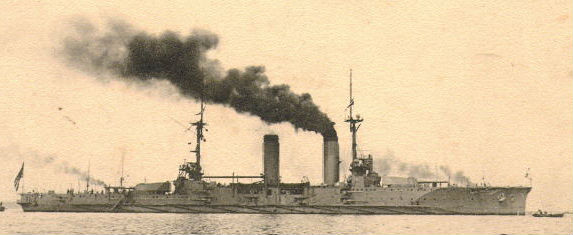
After her return to Japan, Tsukuba was assigned to Captain Hirose Katsuhiko (the brother of the war hero Takeo Hirose) and escorted the United States Navy’s Great White Fleet through Japanese waters on its around-the-world voyage in October 1908. Captain Isamu Takeshita was captain of Tsukuba from July through September 1912, followed by Captain Kantarō Suzuki to May 1913, and Captain Kanji Kato from December 1913 to May 1914.
Tsukuba served in World War I, initially during the blockade of the German port of Tsingtao in China during the Battle of Tsingtao from September 1914, as part of Japan's contribution to the Allied war effort under the Anglo-Japanese Alliance. After the fall of the city, Tsukuba was sent out as part of the search for the German East Asiatic Squadron in the South Pacific until the destruction of the German squadron in the Battle of the Falklands in December 1914. Tsukuba remained in Japanese home waters in 1915 and 1916. On 4 December 1915, Tsukuba was in a fleet review off of Yokohama, attended by Emperor Taishō in which 124 ships participated. A similar fleet review was held again off Yokohama on 25 October 1916.
On 14 January 1917, Tsukuba exploded while in port at Yokosuka. Some 200 crewmen were killed immediately, and over 100 more were drowned as the cruiser sank in shallow waters within twenty minutes, with a total loss of 305 men. The force of the explosion broke windows in Kamakura, more than twelve kilometers away. At the time of the disaster, more than 400 crewmen were on shore leave, which is why so many survived. The cause of the explosion was later attributed to a fire in her ammunition magazine, possibility through spontaneous combustion from deterioration of the Shimose powder in her shells.
The masts, bridge and smokestacks of the vessel remained above water, and afterwards, her hulk was raised, and used as a target for naval aviation training. It was formally removed from the navy list on 1 September 1917 and broken up for scrap in 1918.
- Details
- Category: Newsletters
This is the archive of branch newsletters from 2016.
- Details
- Category: Newsletters
Chairman’s Notes
Good Evening and welcome to the final meeting of 2016. After the talk you are cordially invited to our Christmas Social. The hot pot prepared by Simon Cooper is based on the traditional Trench Stew served to the troops in the front line.
My thanks go to all those have helped me over the year and I would like to wish you a pleasant Christmas. During the Exhortation perhaps we could give a thought to Mike Platt and Mavis Smedley, in particular, who we have lost.
Our speaker tonight is John Hartley. John has spent a lot of time researching all the local servicemen who were lost in the conflict. His excellent work ‘More than a Name’ covers the details of all these men. It is now on line and if you have a relative from Stockport who you are researching, you can do no better than look at it.
I am indebted to John as he very kindly let me use his work as part of my research for those men who appear on the Stockport Corporation War Memorial in the Town Hall Foyer. This has enabled the War Memorial/Hat Works staff to place details of each man in a glass cabinet in the main Town Hall entrance on the 100th anniversary of his death.
1916 will always be synonymous with the Pals Battalions and John will be considering them tonight.
I hope you will all have a prosperous New Year.
Terry Jackson, Chairman.
Last Month’s Talk
Anne Pedley, the archivist of the Royal Welch Fusiliers, combined her interest in the Great War and her home in the Welsh hills to consider the early British mountaineers, many of whom served in the war. The passion for Alpine climbing had developed during the Edwardian era and Snowdonia was a perfect training ground for these new explorers of the high peaks of the Alps and beyond. Several organisations were based there and produced some of the most eminent climbers of the period. After a consideration of these organisations and movements that brought these adventurers together, Anne looked at the lives of several of them.
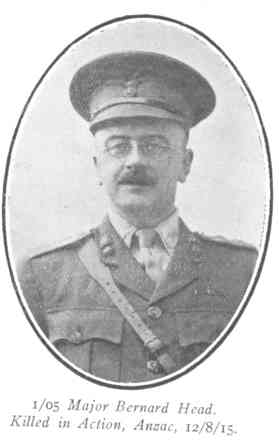
Bernard Head (left) was a major in the Royal Welch Fusiliers. He was originally from New Zealand. He was the first with two others to climb Mount Aspiring (9000 feet) on South Island in 1909. He was killed at Gallipoli on 12 August 1915 and is remembered on the Helles Memorial.
Stanley Fearns Jeffcoat (right). Jeffcoat lived for a while in Buxton. He served with the 22nd Bn Royal Fusiliers. In April 1917 2nd Lt Jefffcoat bombed along the trenches near Oppy, Arras in order to link up with 63 Division. He subsequently died of wounds on 30 April and was posthumously MID. He is buried in Rolincourt Military Cemetery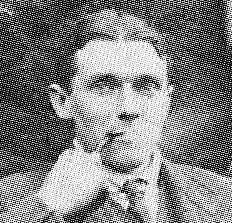
He had been a member of the Fell & Rock Climbing Club.
The most famous mountaineer of the war was George Mallory (below). He had gained a reputation as a fine climber. After studying at Cambridge, he served as a 2nd Lieutenant in the Royal Garrison Artillery on the Somme. He was member of the 1924 British expedition to Everest. He partnered Sandy Irvine on their final attempt to reach the summit, but never returned. In the following years, two separate climbers were to claim they had seen his body. There has been continual speculation as to whether the pair had reached the summit. In 1999 Mallory’s frozen body was found high up on the mountain. He was identified by his name tag sewn into his clothing. Irvine had taken a camera with him, but his body has never been found. It was hoped it might have been with Mallory and would have proved if they reached the peak, but it was not.
The 1924 Everest expedition had initially been led by Charles Granville Bruce (left). He was from a wealthy family, his father being 1st 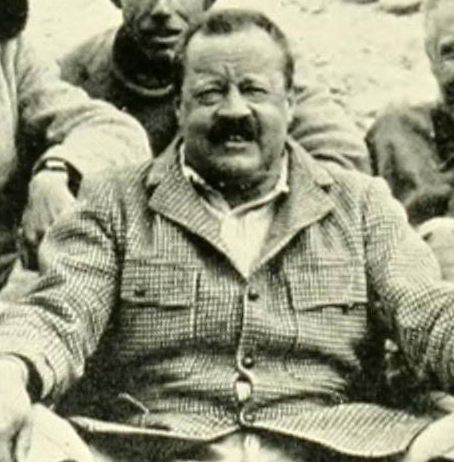 Baron of Aberdare. Bruce became a career soldier and whilst serving with the Ghurkha Riles climbed in the Himalayas. He rose to the rank of Brigadier General and was wounded at Gallipoli. After the war he was President of the Alpine Club 1923-1925. He caught malaria and had to be evacuated during the expedition.
Baron of Aberdare. Bruce became a career soldier and whilst serving with the Ghurkha Riles climbed in the Himalayas. He rose to the rank of Brigadier General and was wounded at Gallipoli. After the war he was President of the Alpine Club 1923-1925. He caught malaria and had to be evacuated during the expedition.
Italy was the scene of fierce fighting in the mountains. Germany’s most famous soldier of the 20th century was Erwin Rommel (below). He came to prominence fighting with the Alpencorps in the Italian mountains. At the Battle of Caporetto in October 1917, he was awarded the ‘Pour le Merité’
Many hill walkers will be familiar with the Fell and Rock Club Memorial on Great Gable. It was placed on the summit in 1924. The original was replaced in 2013 in order to correct some spelling mistakes.
A fascinating study of some of the most well- known climbers of the period. Ed
Below on the left Rommel, and on the right, Mallory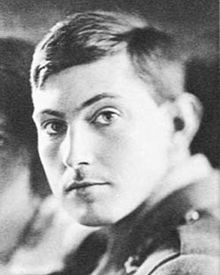
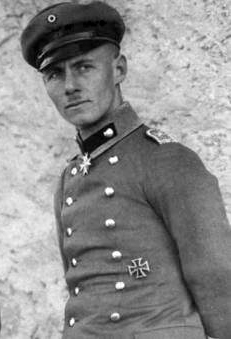
Raffle Prizes
I would like to ask our regular patrons that if they have any military books, especially on the Great War, that they would like to donate for the normal raffles then they would be greatly received at any of our meetings. .
Terry Jackson, Chairman

